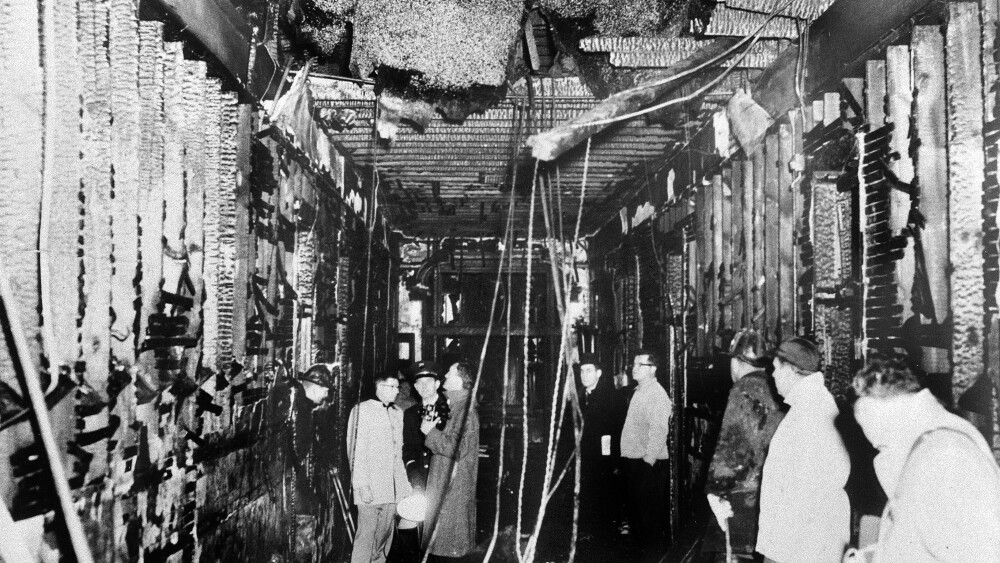What sort of code administration would allow the grandfathering of code requirements knowing that a particular building has all the right ingredients for a deadly fire?
What sort of building management would find acceptable an arrangement of building features with all the ingredients for a deadly fire?
How is it that in 1958 the city of Chicago and the Catholic Diocese of Chicago could fail to see the potential folly of ignoring well-known and thoroughly identified fire risks?
We know about fire hazards and associated risks today because we study fire science and history. In 1958, they knew about the hazards because they were experiencing these fire risks as current events. These sort of fires in buildings with known hazardous features were common back to the 19th century.
They knew the risk of open stairwells lacking fire doors.
They knew the risk of rapid flame spread across the surfaces of heavily varnished wood interiors and trim.
They knew the need for two means of egress or providing an automatic fire sprinkler system.
You’d think they knew the risk of exposing school-age children in a building with those potential hazards.
One need only build the equation factoring in the elements of hazard, risk and occupancy.
Across the board, the responsible adults in authority failed to imagine that the worst could indeed happen.
On Dec. 1, 1958, a fire extending up an open stairwell to the second floor of the north wing of the Our Lady of the Angels School in Chicago resulted in 95 deaths – 92 children and three nuns.
The school
The city of Chicago is known for many things, one is being a city of neighborhoods. In the 1950s, it was also a city of Roman Catholic Church parishes, having roughly one parish for every square mile of the city.
Of the 3 million-plus people living in Chicago, nearly 2 million were Catholics. The parishes were both social and religious anchors for their respective neighborhoods, offering a Catholic education as an alternative to the city’s public schools.
One such neighborhood parish on Chicago’s West Side was Our Lady of the Angels (OLA), located on the corner of Iowa Street and Avers Avenue. The parish was established in 1894 for Irish immigrants. In the 1950s, it served Italian immigrants, with the parish school enrollment at approximately 1,600 students. It was the height of the baby boom, and some OLA classrooms held 60 students.
The tragedy unfolded quickly when a fire broke out in the basement of the school and quickly raced upward via an open stairwell. The fire trapped students and teachers in a terrifying inferno on the second floor. It was a fire of nightmares that would haunt survivors, children and teachers, parents, police officers and firefighters forever.
The fire
It was Dec. 1, 1958, a cold but sunny day, the Monday after Thanksgiving.
The fire began sometime between 2:00 and 2:20 p.m. in a trash barrel. The fire reportedly burned for 20-40 minutes without notice. It grew quickly, sending flames, heat and deadly smoke upward through the open stairwell into the second-floor hallway and ultimately the classrooms, where students and teachers first noticed smoke coming in under the classroom doors. It was just before school dismissal time.
The first report of the fire was a still alarm telephoned to the fire department at 2:42 p.m. In Chicago, a still alarm brought at least one engine, one truck, one squad and a battalion chief.
The initial response from the 18th Battalion brought 16 firefighters, under the command of Chief Miles Devine, with Engine 85, Truck 35, and Squad 6.
Engine 85 was the first unit to arrive at 2:44. Lt. Stanley Wojnicki saw that children from the lower floor were already lined up on Avers Avenue and Iowa Street. But what gripped his immediate attention were the many children crowding the windows on the second floor with fire and smoke showing. Wojnicki immediately requested a box alarm. The fire alarm office coincidently was putting out the same box based on so many calls coming in for a fire at that location.
At 2:47, the battalion chief requested a 2-11 alarm.
At 2:55, a 5-11 alarm was transmitted, bringing 24 engines, seven trucks, five squads, nine ambulances, two light wagons, another division marshal, four pumpers, two Snorkel towers, as well as city fire commissioner, Robert Quinn.
At 2:57, the school’s roof collapsed.
It is believed that at the time of the fire, there were 1,200 to 1,300 occupants in the building. In the two-story, north wing where the fire occurred, there were 569 students and teachers. On the second floor of that wing, there were 329 people in the six classrooms. For those 329 children, escape now meant jumping from the second-floor windows to the concrete and crushed stone below or waiting for the fire department to arrive and effect their rescue.
Many civilians and school personnel were already trying to rescue students from the windows as firefighters quickly raised eight ground ladders from Truck 35 and set up two life nets. One life net was staffed by firefighters Willard Martens and Walter Romanczak of Truck 35 at the northeast corner of the building.
What they saw was horrifying as children were so jammed together in the windows that it was impossible for them to jump one at a time. To escape the fire, the children jumped two or three at a time, hitting the net in quick succession and making it difficult for firefighters to handle the net without being injured.
Other children missed the net and struck the ground. Martens and Romanczak estimated that between 20 and 25 children jumped for their net.
One account of the rescue operation came from Chicago Fire Department Truck 35 Lt. Charles M. Kamin, as shared on the OLA Fire Memorial website:
“When Kamin, in charge of Truck Company 35, arrived he saw the desperate situation in the courtyard between the north and south wings of the school. Children in rooms 209 and 211 were hanging out the windows, yelling and screaming, some jumping. Kamin climbed a ladder placed at the front window of Room 211 and began rescuing children. He repeatedly reached in and grabbed students, mainly boys because he could grab them by their belt, lifted them out and dropped them on the ladder below him. The situation in the room deteriorated fast, though.
After rescuing about 8 children, the air inside the room reached ignition temperature and the entire room erupted in flames, forcing Kamin back from the window. In horror, he watched as the remaining children disappeared in the conflagration.
Kamin and his crew were credited with saving 63 of the 160 children and nuns saved from the burning school by the Chicago Fire Department.
Later that evening, Kamin was treated and released from Garfield Park Hospital for minor injuries.
In a 1977 interview, Kamin said, ‘Every once in a while it still bothers you. You can see those kids, and you hear them. I mean, screaming. I can hear the screams right now. And sometimes you’re OK, but when you sit down sometimes. It really bothers a fellow. It really does about all those kids.’ The tears welled in his eyes with these words.”
In approximately one hour, the fire caused the deaths of 92 students and three nuns as the smoke, heat, fire and toxic gases cut off their means of escape. In addition, approximately 77 more suffered injuries, mostly from jumping from classroom windows on the second floor. (Due to the basement being partially above grade-level, the second floor was the approximate height of a third floor.

Officials examine a charred section of the second floor where the roof collapsed, Dec. 1, 1958, during the fire which claimed 90 lives at the Our Lady of the Angels parochial school in Chicago. Burned out rooms on each side of this corridor bore the brunt of damage and fire officials said most of the children who perished were in these two rooms.
Associated Press
What went wrong
Flames spread quickly across the heavily waxed and varnished wood interior. There was no fire door on the stairwell and no automatic fire sprinkler system. The school’s manual fire alarm did not ring into a city master box. Although heat detection equipment existed at the time, smoke detection technology was yet to be invented.
The school had not been required to comply with city fire code because it had been grandfathered by ordinance. An investigative report published in the January 1959 edition of the NFPA Quarterly criticized the lack of fire protection and life safety features to protect the occupants.
Additionally, the transom windows above the classroom doors had failed, allowing flames, heat and toxic smoke to enter the classrooms where dozens had remained faithfully awaiting rescue. The fire moved into the attic space over their heads, turning the second floor of the old North Wing into a perfect fire trap.
Further complicating the response, firefighters had been incorrectly routed to the church rectory around the corner on West Iowa Street.
Delayed discovery of the blaze and the misdirection of the first apparatus meant the firefighters arrived too late to save more, but it was not their fault. In less than 15 minutes, they rescued and recovered more than 160 children, though many of the students carried out were already dead. Some of the small bodies were so badly charred that they could not be handled without breaking apart. The rescue ultimately set the record for the largest number of people rescued at a single fire by the Chicago Fire Department.
Old lessons ignored
In the estimation of NFPA fire protection engineers, the outcome of this fire might well have been different if the school had not been grandfathered from compliance with existing building exit codes. On the other hand, Chicago Fire Commissioner Quinn disagreed with this opinion and laid the blame for the resulting high loss of life on the delayed alarm.
Soon after the fire, the head of the NFPA was asked what had been learned from the tragedy at Our Lady of the Angels. He responded that there were no new lessons to be learned. Only old lessons that tragically went unheeded.
References
- “Angels Too Soon: The School Fire of ’58” interactive video documentary, produced by WTTW-TV.
- Babcock, C, Wilson, R. “The Chicago School Fire.” NFPA Quarterly, reprint posted on OLA Memorial website.
- OLA Fire Memorial website
- Our Lady of the Angels School fire Wikipedia
- Wood, M. “Tastes Like Burning.” Chicagoist (2005).



